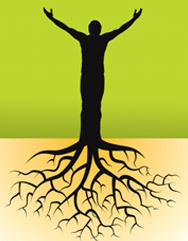Family Tree
For those that don't know, I studied agriculture in university and my specialty was deciduous orchards. I love trees and have planted hundreds all over Israel, from the Golan to the Negev. Tu B'Shvat - the New Year for trees and once of my perennial favorite days - comes out this coming Wednesday.
The Torah tells us that "Man is a tree in the field" (Deuteronomy 20:19). Interestingly, we  automatically refer to our ancestral background as "the family tree." On a superficial level, just as a tree branches out from trunk to branches to twigs above ground – and branches out similarly below the ground, with a root system that looks like an upside-down tree – so do we branch out in two directions. From us to our children to our grandchildren resembles the tree branching out from the trunk above ground, and our parents, grandparents, and successive previous generations are our "roots" below ground, which we don't always see.
automatically refer to our ancestral background as "the family tree." On a superficial level, just as a tree branches out from trunk to branches to twigs above ground – and branches out similarly below the ground, with a root system that looks like an upside-down tree – so do we branch out in two directions. From us to our children to our grandchildren resembles the tree branching out from the trunk above ground, and our parents, grandparents, and successive previous generations are our "roots" below ground, which we don't always see.
Yet, the concept of family tree goes much deeper. Any change at the base of the trunk has a profound effect on the branches, then subsequently on the twigs, and ultimately on the leaves and fruit. For example, if a tree farmer sees that the branches are brittle, the leaves are yellowish, and the color of the fruit is pale, then it shows that the tree is suffering from an acute lack of iron. All the farmer has to do is to give the tree an adequate dose of iron at the base of the trunk and a good dose of water, and presto! Here's what happens:
The iron-fortified water is absorbed from the soil into the roots of the tree. It now travels up through the trunk, the branches, the twigs and to the fruit and leaves by way of long thin tubes called xylem.
Water and nutrients move up the xylem through a process called capillary action. Capillary action allows water to be pulled through the thin tubes because the molecules of the water are attracted to the molecules that make up the tube. The water molecules at the top are pulled up the tube and the water molecules below them are pulled along because of their attraction to the water molecules above them.As such, the iron-fortified water reaches the furthest extremities of the tree and replenishes them. Soon, the branches become stronger, the leaves greener, and the fruit brighter.
The Torah is compared to water (see Isaiah 55:1). Just as Hashem engineered the amazing process of capillary action which moves nutrients and water from the soil and trunk up through the tree, we have an equivalent spiritual process called Ma'ase Avot Siman L'banim – "the deeds of fathers are signs for sons", namely, what one generation does has a profound effect on future generations.
The Gemara tells a poignant story about trees and concern for future generations in a tale about the great tzaddik, Choni Haagal (see tractate Taanit 23a):
Continue reading Family Tree at this week's online issue of Breslev Israel magazine.
Also featured this week:
Rabbi Shalom Arush: Eyes that Shine
Rabbi Nissan Dovid Kivak: Three Pillars of Happiness
Rabbi Avraham HaCohen Kook: Blessings on Miracles
Zev Ballen: Enemies of Hashem
Rivka Levy: The Veggie Tzaddik
Chaya Ovadia: Shaping Up
Yehoshua Goldstein: Let it Shine
Have a wonderful week!
Lazer Brody's Blog
- Lazer Brody's profile
- 7 followers



